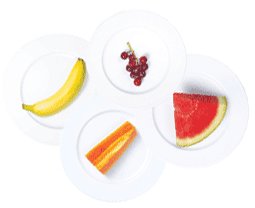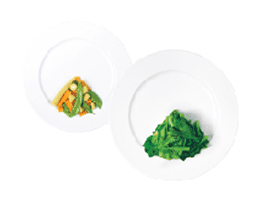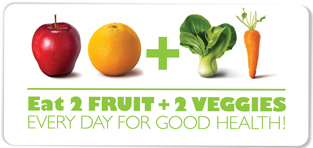Harness the Goodness of Fruit and Vegetables
Date: Thursday, March 04, 2021Learn why nutritionists say that your mother was right when she told you that fruits and vegetables were good for you! Also, pick up a few savvy tips on how you can include enough fruit and vegetables each day to stay in the glow of good health.
Good things come in unexpected ways
Fruit and vegetables - you see them every day in the wet market, supermarket, hawker stalls or on your plate. Sometimes you eat them and at other times, you ignore them. You rarely pay them much attention. Before you dismiss them as boring, cheap and everyday food, take a few minutes to understand the benefits of eating more fruit and vegetables. Here are some fascinating things that you may not have known about their wholesome goodness.
1. The goodness of fruit and vegetables
Fruit and vegetables are naturally low in energy, fat, and salt. They are also wonderful sources of fibre and many vitamins, minerals and phytochemicals - natural components in fruit and vegetables that offer health benefits beyond nutrition.
Scientific evidence shows that those who eat a diet rich in fruit and vegetables have a lower risk of many diseases, including heart disease, stroke and certain cancers. Health promotion authorities worldwide encourage people to include more fruit and vegetables in their diet.
2. Variety is the key
When it comes to fruit and vegetables, we are truly spoilt for choice in Singapore. Any wet market or supermarket would have an abundant display of produce from all over the world.
While fruit and vegetables have some common nutritional values, they do differ in their actual composition. For example, some are higher in fibre, while others may provide you more vitamin C, beta-carotene or potassium. Even the different colour pigments in fruit and vegetables offer unique health benefits. So, eat a variety of these wonderful gifts of nature to ensure your wellness and health.
Nutrition experts recommend that you select different colours of fruit and vegetables: red, green, yellow/orange, white or purple - for maximum health benefits. See the table below for examples:
| Colour | Vegetables | Fruit |
|---|---|---|
| Red | Red peppers, tomatoes | Watermelon, cherries |
| Yellow/Orange | Carrots, pumpkin, yellow peppers | Papaya, oranges, rockmelon |
| Green | Green leafy vegetables, broccoli | Kiwi, honeydew melon |
| White | Cabbage, cauliflower | White turnips, bananas |
| Purple | Eggplant, purple cabbage | Plums, purple grapes |
While fresh whole fruit and vegetables definitely have the nutrient edge, other options such as frozen, dried or canned can add variety to your diet. Read on for some tips on these options:
Frozen fruit and vegetables are just as nutritious as fresh produce. So, keep a few handy bags at home. You can use some when your fresh supplies run out midweek. To preserve the nutrients, take them straight out of the freezer and add it to your dish. Do not thaw or soak before you use them.
When you select dried fruit, opt for those with less sugar. Read the Nutrition Information Panel on packaged food to find out the sugar content of the fruit.
If you want to buy canned fruit, choose products canned in juice rather than those canned in heavy syrup. If you do buy fruit canned in heavy syrup, drain away the canning liquid. Check the labels of canned vegetables and pick those that are canned in water. If the vegetables are canned in brine, make sure the canning liquid is drained.
3. Eat enough
Most of us eat some fruit and vegetables every day, but a few strands of bean sprouts and a few green leaves on our plate are not enough. Though a little fruit and vegetables are better than none, you need to eat enough to enjoy all the health benefits. The Health Promotion Board encourages everyone to eat 2 servings of fruit and 2 servings of vegetables each day. Here are examples of 1 serving of fruit and 1 serving of vegetables:
| Fruits | |
|---|---|
|
 |
| Vegetables | |
|
 |
4. Let's get practical
While we all know the goodness of fruit and vegetables, not many of us are committed to include them in the diet. Here are some practical tips to help you achieve 2+2 every day:

At breakfast, you can add some fruit into ready-to-eat cereals or complete your meal with a slice of fruit or a glass of fresh fruit juice.
When ordering an 'economy rice' meal, ask for 2 vegetables and 1 meat dish. Complete your meal with a slice of fresh cut fruit.
When eating at home, do make sure to provide enough vegetables for everyone to have at least 1 serving. Remember to end your meal with some fruit.
If you are out for a meal at a fancy restaurant, order at least 2 vegetable dishes and a plate of fresh cut fruit instead of dessert.
If you like to have a snack between meals, have a fruit such as a banana or some grapes.
So Remember...

Enjoy a variety of fruit and vegetables each day. Choose different colours to enjoy the unique nutritional and health benefits of each.
Eat 2 servings of fruit and 2 servings of vegetables each day. Eat 2 servings of fruit and 2 servings of vegetables each day.
Include fruit and vegetables in meals and snacks to ensure you are eating enough.
Contributed By: Health Promotion Board (HPB)
Harness the Goodness of Fruit and Vegetables by Health Promotion Board, 12 Aug 2020, www.healthhub.sg.